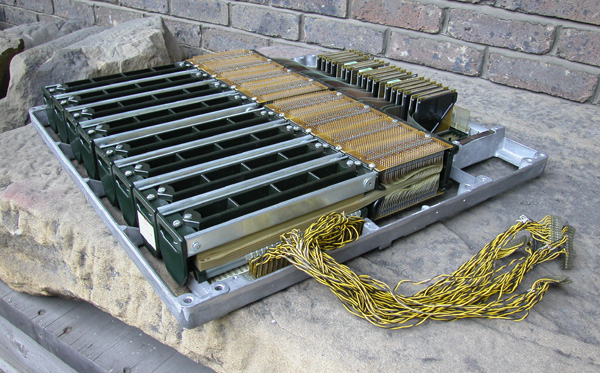

It weighs 15.8 Kg, is 576mm x 560mm x 85mm.
Before answering the question, there is a need to
set the scene.
In computers there is: hardware; software; and firmware.
(Some say there is also wetware, which is the people who use computers.)
Hardware is the stuff that you can touch, or hit with your knuckle.
Software is the information created by people
that is instructions to be executed by the hardware
to perform some computing task.
e.g. to analyse a bridge to see if it is strong enough,
to calculate the pay for each employee,
...
Firmware is halfway between.
It is information that is stored in the hardware that is instructions,
just as in software, but it is provided by the manufacturer
and (generally) cannot be changed by the computer user/owner,
that is interpreted and executed by the hardware
so as to enhance the capabilities of the hardware.
Now firmware had been around some time before 1964.
But in 1964 International Business Machines (IBM) Corp
announced
a range of computers that it named
System 360.
These are mainframe computers,
if you do not know what a mainframe computer was like you can get an
idea
Here.
In the 360 range of computers, firmware was crucially part of its architecture.
The lower specification computers had not much hardware and a lot of firmware.
They were cheaper but not so fast.
The higher up the range, there was less firmware and more hardware,
and so much faster, and more expensive.
For example, the System 360 Model 30 had an internal data path of 8 bits.
Which meant to add two word length (32 bit) integers,
required the hardware under control of the firmware
to add two eight bits in four loops involving 5 computer cycles.
(The total number of computer cycles was:
9 cycles to decode the instruction and fetch the data;
4 loops of 5 cycles to add the four succesive pairs of 8 bits;
then 5 computer cycles to store the result and set-up for the next instruction.
That is a total of 34 cycles.)
Whereas the top of the range System 360 Model 65 had the hardware
to add two double length (64 bit) integer words in one computer cycle.
The following is taken from [1]
| M30 | M40 | M50 | M65 | |
|---|---|---|---|---|
| minimum rental fee ($K/mo.) | 4 | 7 | 15 | 35 |
| Knight index - scientific (Kops) | 8 | 33 | 187 | 1390 |
| Knight index - commercial (Kops) | 17 | 50 | 149 | 810 |
| internal data path width (bits) | 8 | 16 | 32 | 64 |
| main memory cycle time (ns) | 1500 | 2500 | 2000 | 750 |
| main memory bandwidth (Kbps) | 5 | 6 | 16 | 85 |
| control store width (bits) | 50 | 52 | 85 | 87 |
| control store cycle time (ns) | 750 | 625 | 500 | 200 |
| control store bandwidth (Kbps) | 67 | 83 | 170 | 435 |
| control store size (K microinsts.) | 4 | 4 | 2.75 | 2.75 |
| control store technology | CCROS | TROS | BCROS | BCROS |
The power of each model was a combination of:
- main memory bandwidth.
- internal data path width.
- control store bandwidth.
and inversely proportional to:
control store size.
From this you can understand that the control store was doubly important.
The control store was the firmware,
the instructions of the firmware had to be stored somewhere,
it was in Read-Only Storage (ROS).
The answer to the initial question is,
a Transformer Read-Only Storage module. (TROS)
It came from the control unit that 9 disk drives were connected to.
There was three types of ROS:-
TROS - Transformer Read-Only
Storage;
BCROS - Balanced Capacitor Read-Only Storage;
CCROS - Card Capacitor Read-Only Storage.
To find out more about the history of firmware you could read Microprogramming History
[2] EW Pugh, LR Johnson, and JH Palmer. IBM's 360 and Early 370 Systems. Cambridge, MA: MIT Press, 1991.
[3] A Padegs. System/360 and Beyond. IBM Jrnl. Res. Dev. 25n5:377-390, 1981.
[4] M Phister Jr. Data Processing Technology and Economics. 2nd ed. Bedford, MA: Digital Press, 1979.